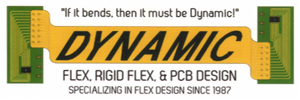Usage of Flex Circuit Design in Industries & Applications
The configurations and applications of using flexible printed circuits are restricted only by your imagination. Usually, flex circuits are designed for situations where:
- Continuous flexing is required
- A circuit is bent once or multiple times during package assembly
The sophisticated packaging of today requires complex mechanical and electrical interfaces. Flexible circuits offer the electrical connection while simplifying the mechanical challenges that don’t seem to die down.
For instance, miniaturization demands increased the performance of every component.
Flexible printed circuits offer electrical and mechanical interfaces cost-effectively in small packages. While designing flex, there is a considerable matrix of material and design choices.
The performance of a flexible circuit is directly dependent on the selection of material and design, along with the understanding of the application.
Automotive
The role of flex circuit design in the automotive industry is gaining prominence. Currently, a top-level vehicle comprises over 200 electronic control units, with some of them being processors and sensors applied in the cockpit of a car.
The value of such electronic products serving for automotive lies in chassis, body, and dynamic systems, with the majority of them being concerned with digital power. The application of flex circuit design in automotive aims to increase auto performance by covering the following aspects:
- Environment improvement referring to fuel transformation from gasoline, fuel-saving, etc.
- Security enhancement lying in reducing traffic accidents, ranging from radar monitoring to autonomous driving.
- Comfort and convenience are generally rooted in audio, navigation, etc.
Computers & Peripherals
Often, flex circuits are used as connectors in a variety of applications where production constraints, space savings, and flexibility restrict the serviceability of hand wiring or rigid circuit boards.
In computers and peripherals, a common application of flex circuits may be found in keyboards, with the majority of the keyboards using flex circuits for the switch matrix.
In computer peripherals, the use of flex circuits lies in moving the print head of printers and to connect signals to the moving arm consisting of read/write heads of disk drives.
Consumer
While standard PCBs are quite small, some applications entail flexibility. The flexible printed circuits can offer consumers with a plethora of options that a standard PCB design may fail to deliver.
Originally, flex circuits were developed to replace conventional wiring harnesses. However, they are now frequently used in consumer electronics like disk drives, print heads, digital cameras, and cellphones. If a consumer requires a large number of electrical connections in a small package, flexible printed circuits will be of substantial assistance.
Industrial Controls
There are a number of reasons why flex circuit design is important for industrial controls, with the foremost being that these circuits can be designed to match up with the core product or electronic device. In industrial controls, manufacturers aren’t forced to create a casing or product around the board itself.
Instead, they can permit the board to fit an existing design. This is especially beneficial when creating hardware or components that feature orthodox designs. For example, if you’re concerned with the durability, portability, and total weight of a specific device, traditional boards may be out of the question.
Medical
The use of flex circuit design in medical is quite prevalent. Precisely, it is used extensively in the following medical devices:
Implantable medical devices: These devices comprise defibrillators, neurological implants, pacemakers, and cochlear implants (hearing). These devices are surgically implanted in the human body. Here, flexible circuitry is used because the product requirements are inclusive of extreme reliability, durability, compactness in size, and lightweight.
Non-implantable medical devices: These devices comprise hearing aids, drug dispensing systems, and external defibrillators. These devices are typically attached to the skin and worn by a patient, therefore requiring flexible devices.
Instruments
Flex circuits are usually used for surgical instruments; for example, those used for minimally invasive procedures. This is because these circuits offer favorable chemical and thermal stability, allowing for repeat sterilization and cleaning. For instance, Ticona produced medical forceps, which included PPS into the handles, permitting ergonomic and lightweight design.
Telecom
Pick up any smartphone, and most probably, you will find a flex circuit board placed inside it, providing substantial computing power. Flex circuits are an important component of the telecommunications industry. You’ll discover flex circuit boards in almost every major telecommunication product, from services and routers to phone switching systems and online signal expansion systems.
By using flexible circuitry, this industry continues to push technology forward, consistently seeking to reduce the weight and size, while also adding features continuously to keep the competitors at bay.
Military & Aerospace
Flex circuits offer the ability to design circuitry to fit your device instead of creating a device to fit the circuit board. They are designed for the rigors of military, medical, and aerospace applications, with dependable reliability. Following are some of the instances in which this circuitry is used in this domain:
- A substrate is used to carry components in satellites because it offers chemical resistance and thermal stability.
- Radar systems are used by a plethora of rigid-flex applications, which offers them simplified assembly and interconnect cost savings.
- Flex circuits may also be used in jet engine controls to replace harness assemblies. Using flex circuits increases reliability and lowers assembly costs.
But when do we use flex?
Answer the following questions to check when we use flex:
- Enable or eliminate the use of less expensive, smaller connections
- Is the dynamic flexing of circuits required?
- Is impedance control or shielding required?
- Is reliability critical?
- Does assembly labor require reduction?
- Is weight an important consideration?
- Is space constraint important?
- Density – are more than 20 conductors required?

